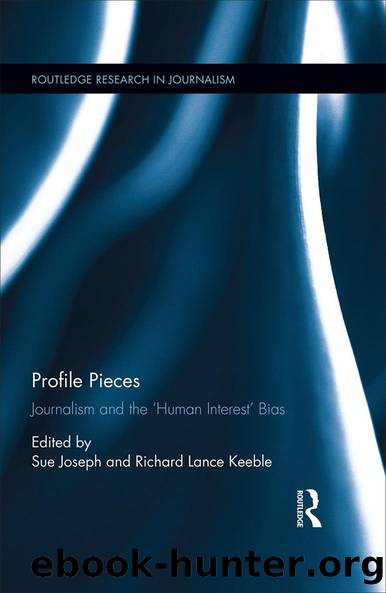Profile Pieces by Sue Joseph Richard Lance Keeble

Author:Sue Joseph, Richard Lance Keeble [Sue Joseph, Richard Lance Keeble]
Language: eng
Format: epub
Tags: Nonfiction, Reference & Language, Language Arts, Journalism, Writing & Publishing, Publishing, Social & Cultural Studies, Social Science
ISBN: 9781317383536
Publisher: Taylor and Francis
Published: 2015-10-14T04:00:00+00:00
Muriel Rukeyser: Investigative Reporter and Poet/Journalist
Like Charles Reznikoffâs Testimony and Mark Nowakâs Shut Up Shut Down, Muriel Rukeyserâs The Book of the Dead announces the continuing significance of experimental American poetry in relation and in response to objectified news in the twentieth and twenty-first centuries. Documenting an outbreak of silicosis in Gauley Junction, West Virginia, and its effect on miners working for Union Carbide Company, The Book of the Dead was first published in Rukeyserâs 1938 collection, U.S. 1. The historic tragedy at Gauley Junction, the most serious industrial accident in the United States up to that time, led to a class-action suit and congressional investigation. In the poem, Rukeyser draws on legal documents, interviews, scientific reports, documentary film techniques, and journalistic devices to create her profiles of ordinary people. Along with her first collection, Theory of Flight (1935) and early journalism, this volume has contributed most strongly to giving Rukeyser the moniker of activist, âpoet-journalistâ, prompting Adrienne Rich to call her âpoet journalist pioneer motherâ (Rich 1993: 150).6
But Rukeyserâs work as an actual investigative reporter began long before the Gauley Bridge disaster with her coverage of the 1932 Scottsboro trial in which nine young black men were accused of raping two white women. Through her journalistic efforts, she also supported the Spanish Loyalists during the Spanish Civil War in the 1930s and various Vietnam protest campaigns in the 1970s (Lowney 2006: 34; Vasser Encyclopedia 2014: 1â7). As Julian Lobo has argued in reference to the journalistic coverage of Gauley Bridge: âBy 1935, news of the Gauley Bridge disaster began to circulate, at first in radical venues such as the Peopleâs Press and New Masses. But as Time, The Nation, and The New York Times began to take notice, especially in the wake of the House subcommittee hearings in early 1936, the death at Gauley Bridge became national newsâ (Lobo 2012: 78). Rukeyserâs The Book of the Dead is her poeticised âjournalisticâ response to the disaster.
In basing her profiles on such contemporary news events as the Gauley disaster, Rukeyser found one of her most powerful natural expressions in the combinative form of poetry and news. The Book of the Dead juxtaposes the poetic forms of lyric and a reliance on modernistic and mythic structures (i.e. the Egyptian Book of the Dead, featuring a cyclic structure of burial and rebirth, and a journey to an underworld) with the discursive forms of objective journalism. Moreover, Rukeyserâs âjournalisticâ techniques â relating her news from the midpoint rather than the beginning of a testimony (paralleling Reznikoff) â reflects her uniquely creative use of the documents she acquired as an investigative reporter. These documents included those from Indiana representative Glenn Griswold, the chairman of the subcommittee investigating Gauley Bridge, and the 1 April 1936 Congressional Record (Lobo 2012: 78). Through such techniques, Rukeyser makes her poeticised profiles â pared down and presented through her âeditingâ â essential to her news-making process.
The collectionâs free verse style, like that of Testimony, is best suited to what is
Download
This site does not store any files on its server. We only index and link to content provided by other sites. Please contact the content providers to delete copyright contents if any and email us, we'll remove relevant links or contents immediately.
| Publishing & Books | Research |
| Writing |
Asking the Right Questions: A Guide to Critical Thinking by M. Neil Browne & Stuart M. Keeley(5577)
Autoboyography by Christina Lauren(5155)
Eat That Frog! by Brian Tracy(4381)
Dialogue by Robert McKee(4272)
Sticky Fingers by Joe Hagan(4064)
Journeys Out of the Body by Robert Monroe(3539)
Annapurna by Maurice Herzog(3398)
Full Circle by Michael Palin(3350)
Schaum's Quick Guide to Writing Great Short Stories by Margaret Lucke(3281)
Elements of Style 2017 by Richard De A'Morelli(3280)
The Art of Dramatic Writing: Its Basis in the Creative Interpretation of Human Motives by Egri Lajos(2945)
Why I Write by George Orwell(2851)
The Diviners by Libba Bray(2841)
In Patagonia by Bruce Chatwin(2830)
The Mental Game of Writing: How to Overcome Obstacles, Stay Creative and Productive, and Free Your Mind for Success by James Scott Bell(2819)
The Fight by Norman Mailer(2802)
Atlas Obscura by Joshua Foer(2759)
Venice by Jan Morris(2496)
The Elements of Style by William Strunk and E. B. White(2416)
